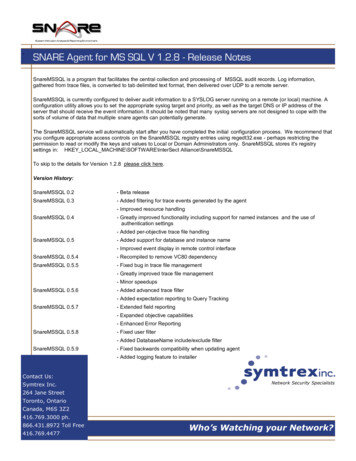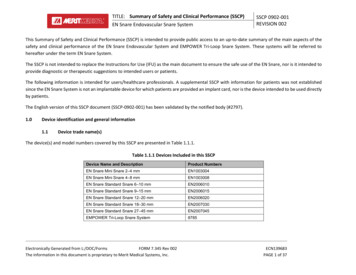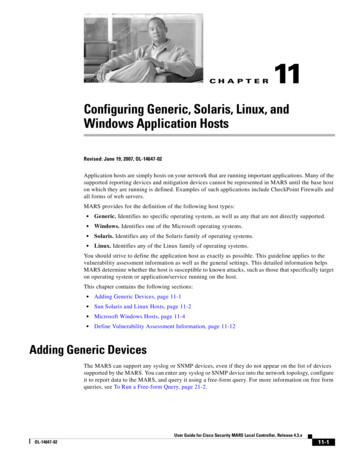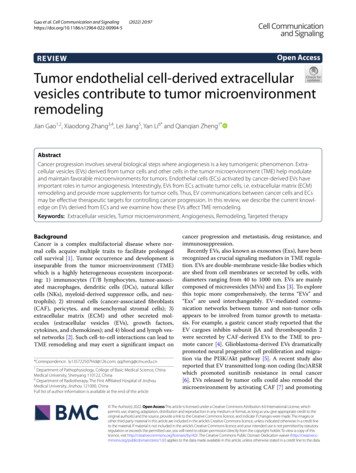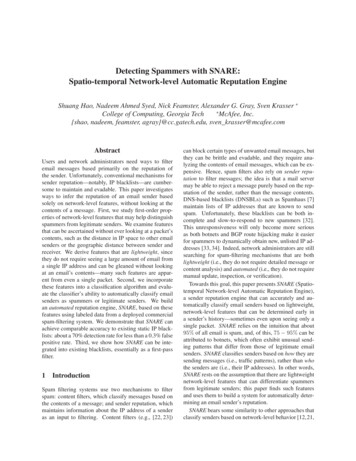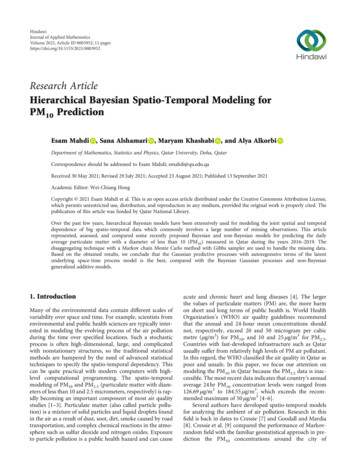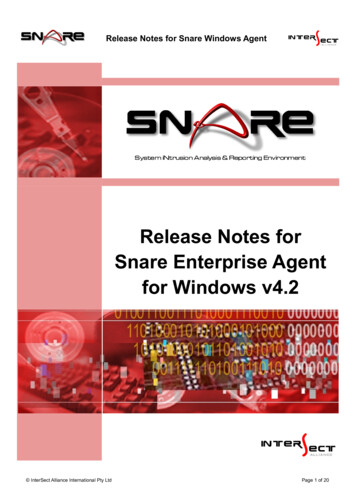
Transcription
Detecting Spammers with SNARE:Spatio-temporal Network-level AutomaticReputation EngineShuang Hao, Nadeem Ahmed Syed, Nick Feamster,Alexander G. Gray, Sven Krasser
MotivationSpam: More than Just a NuisanceSpam:unsolicited bulkemailsHam:legitimate emails fromdesired contacts 95% of all email traffic is spam(Sources: Microsoft security report, MAAWG and Spamhaus)– In 2009, the estimation of lost productivity costs is 130 billion worldwide(Source: Ferris Research) Spam is the carrier of other attacks– Phishing– Virus, Trojan horses, by S. Hao, N. A. Syed, N. Feamster, A. Gray, S. Krasser
MotivationCurrent Anti-spam Methods Content-based filtering: What is in the mail?– More spam format rather than text (PDF spam 12%)– Customized emails are easy to generate– High cost to filter maintainers IP blacklist: Who is the sender? (e.g., DNSBL)– 10% of spam senders are from previously unseen IPaddresses (due to dynamic addressing, new infection)– 20% of spam received at a spam trap is not listed inany blacklistsby S. Hao, N. A. Syed, N. Feamster, A. Gray, S. Krasser
MotivationSNARE: Our Idea Spatio-temporal Network-level AutomaticReputation Engine– Network-Based Filtering: How the email is sent? Fact: 75% spam can be attributed to botnets Intuition: Sending patterns should look differentthan legitimate mail– Example features: geographic distance, neighborhooddensity in IP space, hosting ISP (AS number) etc.– Automatically determine an email sender’s reputation 70% detection rate for a 0.2% false positive rateby S. Hao, N. A. Syed, N. Feamster, A. Gray, S. Krasser
MotivationWhy Network-Level Features? Lightweight– Do not require content parsing Even getting one single packet Need little collaboration across a large number ofdomains– Can be applied at high-speed networks– Can be done anywhere in the middle of the network Before reaching the mail servers More Robust– More difficult to change than content– More stable than IP assignmentby S. Hao, N. A. Syed, N. Feamster, A. Gray, S. Krasser
OutlineTalk Outline MotivationData From McAfeeNetwork-level FeaturesBuilding a ClassifierEvaluationFuture WorkConclusionby S. Hao, N. A. Syed, N. Feamster, A. Gray, S. Krasser
DataData Source McAfee’s TrustedSource email sender reputationsystemDomain– Time period: 14 daysMail ServerOctober 22 – November 4, 20072) Lookup– Message volume:1) EmailEach day, 25 million email3) Feedbackmessages from 1.3 million IPsUserRepository– Reported appliancesServer2,500 distinct appliances ( recipient domains)– Reputation score: certain ham, likely ham, certainspam, likely spam, uncertainby S. Hao, N. A. Syed, N. Feamster, A. Gray, S. Krasser
FeaturesFinding the Right Features Question: Can sender reputation be established fromjust a single packet, plus auxiliary information?––––Low overheadFast classificationIn-networkPerhaps more evasion resistant Key challenge– What features satisfy these properties and candistinguish spammers from legitimate senders?by S. Hao, N. A. Syed, N. Feamster, A. Gray, S. Krasser
FeaturesNetwork-level Features Feature categories– Single-packet features– Single-header and single-message features– Aggregate features A combination of features to build a classifier– No single feature needs to be perfectly discriminativebetween spam and ham Measurement study– McAfee’s data, October 22-28, 2007 (7 days)by S. Hao, N. A. Syed, N. Feamster, A. Gray, S. Krasser
FeaturesSummary of SNARE FeaturesCategoryFeaturesgeodesic distance between the sender and the recipientaverage distance to the 20 nearest IP neighbors of the senderSingle-packetprobability ratio of spam to ham when getting the messagestatus of email-service ports on the senderAS number of the sender’s IPSingle -header/messagenumber of recipientlength of message bodyaverage of message length in previous 24 hoursstandard deviation of message length in previous 24 hoursAggregatefeaturesaverage recipient number in previous 24 hoursstandard deviation of recipient number in previous 24 hoursaverage geodesic distance in previous 24 hoursstandard deviation of geodesic distance in previous 24 hoursTotal of 13 features in useby S. Hao, N. A. Syed, N. Feamster, A. Gray, S. Krasser
FeaturesSingle-packet BasedWhat Is In a Packet? Packet format (incoming SMTP example)IP HeaderSource IP,Destination IPTCP HeaderDestinationport : 25SMTPText CommandEmpty for the first packet Help of auxiliary knowledge:– Timestamp: the time at which the email was received– Routing information– Sending history from neighbor IPs of the email senderby S. Hao, N. A. Syed, N. Feamster, A. Gray, S. Krasser
Single-packet Based (1)FeaturesSender-receiver Geodesic DistanceLegitimate senderclosedistantSpammerRecipient Intuition:– Social structure limits the region of contacts– The geographic distance travelled by spam from botsis close to randomby S. Hao, N. A. Syed, N. Feamster, A. Gray, S. Krasser
FeaturesSingle-packet Based (1)Distribution of Geodesic Distance Find the physical latitude and longitude of IPs based on theMaxMind’s GeoIP databaseCalculate the distance along the surface of the earth90% of legitimatemessages travel 2,500miles or less Observation: Spam travels furtherby S. Hao, N. A. Syed, N. Feamster, A. Gray, S. Krasser
Single-packet Based (2)FeaturesSender IP Neighborhood DensitySubnetLegitimate senderSpammerRecipient Intuition:– The infected IP addresses in a botnet are close to oneanother in numerical space– Often even within the same subnetby S. Hao, N. A. Syed, N. Feamster, A. Gray, S. Krasser
FeaturesSingle-packet Based (2)Distribution of Distance in IP Space IPs as one-dimensional space (0 to 232-1 for IPv4)Measure of email sender density: the average distance to its knearest neighbors (in the past history)For spammers, knearest sendersare much closerin IP space Observation: Spammers are surrounded by otherspammersby S. Hao, N. A. Syed, N. Feamster, A. Gray, S. Krasser
Single-packet Based (3)FeaturesLocal Time of Day At SenderLegitimate senderSpammerRecipient Intuition:– Diurnal sending pattern of different senders– Legitimate email sending patterns may more closelytrack workday cyclesby S. Hao, N. A. Syed, N. Feamster, A. Gray, S. Krasser
FeaturesSingle-packet Based (3)Differences in Diurnal Sending Patterns Local time at the sender’s physical locationRelative percentages of messages at different time of the day(hourly)Spam “peaks” atdifferent local time ofday Observation: Spammers send messages according tomachine power cyclesby S. Hao, N. A. Syed, N. Feamster, A. Gray, S. Krasser
FeaturesSingle-packet Based (4)Status of Service Ports Ports supported by email service providerProtocolPortSMTP25SSL SMTP465HTTP80HTTPS443 Intuition:– Legitimate email is sent from other domains’ MSA(Mail Submission Agent)– Bots send spam directly to victim domainsby S. Hao, N. A. Syed, N. Feamster, A. Gray, S. Krasser
FeaturesSingle-packet Based (4)Distribution of number of Open Ports Actively probe back senders’ IP to check out what service ports openSampled IPs for test, October 2008 and January 2009 1% 1% 2%7% 1% 4%8%33%90% of spammingIPs have none ofthe standard mailservice ports open55%90%SpammersLegitimate senders Observation: Legitimate mail tends to originate frommachines with open portsby S. Hao, N. A. Syed, N. Feamster, A. Gray, S. Krasser
FeaturesSingle-packet Based (5)AS of sender’s IP Intuition: Some ISPs may host more spammers thanothers Observation: A significant portion of spammers comefrom a relatively small collection of ASes*– More than 10% of unique spamming IPs originate fromonly 3 ASes– The top 20 ASes host 42% of spamming IPs*RAMACHANDRAN, A., AND FEAMSTER, N. Understanding the network-level behavior of spammers.In Proceedings of the ACM SIGCOMM (2006).by S. Hao, N. A. Syed, N. Feamster, A. Gray, S. Krasser
FeaturesSummary of SNARE FeaturesCategoryFeaturesgeodesic distance between the sender and the recipientaverage distance to the 20 nearest IP neighbors of the senderSingle-packetprobability ratio of spam to ham when getting the messagestatus of email-service ports on the senderAS number of the sender’s IPSingle -header/messagenumber of recipientlength of message bodyaverage of message length in previous 24 hoursstandard deviation of message length in previous 24 hoursAggregatefeaturesaverage recipient number in previous 24 hoursstandard deviation of recipient number in previous 24 hoursaverage geodesic distance in previous 24 hoursstandard deviation of geodesic distance in previous 24 hoursTotal 13 features in useby S. Hao, N. A. Syed, N. Feamster, A. Gray, S. Krasser
ClassifierSNARE: Building A Classifier RuleFit (ensemble learning)––––is the prediction result (label score)are base learners (usually simple rules)are linear coefficients ExampleRule 1Rule 20.080 00.080Geodesic distance 63 AND AS in (1901, 1453, )0.257Port status: no SMTP service listeningFeature instance of a messageGeodesic distance 92, AS 1901, port SMTP is openby S. Hao, N. A. Syed, N. Feamster, A. Gray, S. Krasser
OutlineTalk Outline MotivationData From McAfeeNetwork-level FeaturesBuilding a cting “Fresh” SpammersIn Paper: Retraining, Whitelisting, Feature Correlation Future Work Conclusionby S. Hao, N. A. Syed, N. Feamster, A. Gray, S. Krasser
EvaluationEvaluation Setup Data– 14-day data, October 22 to November 4, 2007– 1 million messages sampled each day (only considercertain spam and certain ham) Training– Train SNARE classifier with equal amount of spam andham (30,000 in each categories per day) Temporal Cross-validation– Temporal window shiftingTrial 1 Trial 2TrainTestData subsetby S. Hao, N. A. Syed, N. Feamster, A. Gray, S. Krasser
EvaluationReceiver Operator Characteristic (ROC)– False positive rate Misclassified ham/Actual ham– Detection rate Detected spam/Actual spam(True positive rate)FP under detection rate 70%FalsePositiveSingle Packet0.44%Single Header/Message0.29%24 Hour History0.20%As a first of line of defense, SNARE is effectiveby S. Hao, N. A. Syed, N. Feamster, A. Gray, S. Krasser
EvaluationDetection of “Fresh” Spammers “Fresh” senders– IP addresses notappearing in theprevious trainingwindows Accuracy– Fixing the detectionrate as 70%, the falsepositive is 5.2%SNARE is capable of automatically classifying‘fresh’ spammers (compared with DNSBL)by S. Hao, N. A. Syed, N. Feamster, A. Gray, S. Krasser
Future WorkFuture Work Combine SNARE with other anti-spam techniques toget better performance– Can SNARE capture spam undetected by othermethods (e.g., content-based filter)? Make SNARE more evasion-resistant– Can SNARE still work well under the intentionalevasion of spammers?by S. Hao, N. A. Syed, N. Feamster, A. Gray, S. Krasser
ConclusionConclusion Network-level features are effective to distinguishspammers from legitimate senders– Lightweight: Sometimes even by the observation fromone single packet– More Robust: Spammers might be hard to change allthe patterns, particularly without somewhat reducingthe effectiveness of the spamming botnets SNARE is designed to automatically detectspammers– A good first line of defenseby S. Hao, N. A. Syed, N. Feamster, A. Gray, S. Krasser
McAfee's TrustedSource email sender reputation system - Time period: 14 days October 22 - November 4, 2007 - Message volume: Each day, 25 million email messages from 1.3 million IPs - Reported appliances 2,500 distinct appliances ( recipient domains) - Reputation score: certain ham, likely ham, certain



